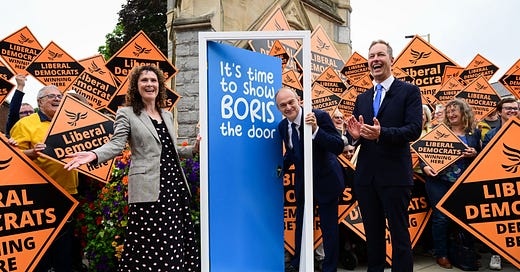The Liberal Democrats celebrate winning the Tiverton and Honiton by-election in their own indomitable style (Photo by Finnbarr Webster/Getty Images)
The most interesting feature of the by-elections last week was the extremely high level of tactical voting in Tiverton and Honiton. As happened in North Shropshire, late last year, the Liberal Democrats came from third place to win, supported by a huge drop in the Labour vote.
This isn’t normal, even in by-elections. For instance, in 1994 and 1995 there were two where the Lib Dems were in second place but Labour had a substantial vote – in Eastleigh, and Littleborough and Saddleworth. Paddy Ashdown’s party won them both, but in each case the Labour vote also went up, with the Tories dropping to third place.
The idea that Labour would effectively cede seats like Tiverton is a recent one and has proved costly to the Tories. The big question, though, is how replicable this might be in a general election where parties must fight everywhere at once and media attention is spread far more thinly. The answer will have significant implications as polls show just under two-thirds of the population currently supporting a party to the left of the Tories. The more this operates as a single anti-Tory vote the more trouble they are in.
Of course First Past The Post makes strategic voting much harder than proportional or preferential voting systems. We know from British Election Study data that consistently only around 10% of people say, after an election, that they voted tactically (though, as we will see, this doesn’t tell the whole story). Moreover tactical voting to protect an incumbent is more straightforward than relying on it to win a seat. Around three quarters of voters know which party holds their seat, but only around 30% know who is in second place. This rises to just over half for the most marginal seats but there’s still a big information barrier to overcome.
To understand what difference tactical voting could make at the next election we’ll start with a brief history of its influence since 1997; then look at what might be different next time using a scenario based on current polls. That will allow us to draw some general conclusions about the impact it could have, and how that vote could be maximised.
Keep reading with a 7-day free trial
Subscribe to Comment is Freed to keep reading this post and get 7 days of free access to the full post archives.




